Extrems in trading: how to determine correctly? 3 Rules
It is impossible to profitably trade in financial markets without knowledge of how to “read” the mood of the market and find optimal points for entering the deal.

For this, there are many different methods and technicians, but the most important tool remains a technical analysis.
It is it that allows you to correctly determine the movement of the price on the graphics. The concept of extremum is one of the most important in this type of analysis.
Extremes in trading - it is about them that we will talk about them today in cooperation with the NPBFX .
What are extremums in trading?
Without theory, nowhere. Local extremums are called both maximum and minimum prices for any period of time.
Volumes in stock trading and their impact on the trend
Exchange trading volumes play a huge role in trading; they help traders determine trends and traders' interest in a particular asset.
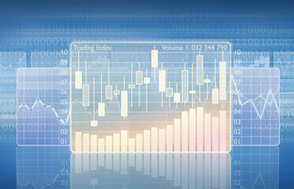
What is exchange volume?
In a market, volume is a measure of how many assets (currencies, stocks, commodities) are bought or sold over a given period of time.
Today, there are many indicators that can help you analyze the market situation and determine the strength of the current trend.
Volume indicators show the total amount of transactions that were concluded on the exchange over a certain time period; such scripts are one of the most popular trading platform tools.
Basics of technical analysis that will help you make money on the stock exchange
Technical analysis is the tool that is used to study the behavior of the price of an asset on the stock exchange.

Moreover, it doesn’t really matter what you are going to analyze - the stock market or forex, the trend movement occurs under the influence of the same factors.
Therefore, if you have studied technical analysis while working on one of the exchanges, you can successfully apply it in other markets.
The basics of technical analysis are designed to give the novice trader basic knowledge of how this process works and what tools are best to use to improve work efficiency.
It would also be a good idea to learn about the orderliness of the work and the correct formulation of conclusions based on the data obtained. So, what is the basis of technical analysis?
What is the Wyckoff method in trading, part one - basic fundamentals and 3 laws
Most of us have come across two methods of market analysis - fundamental and technical.
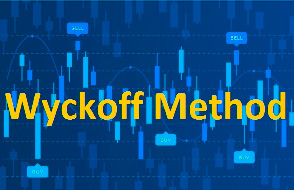
Each method uses many different tools, but in general, fundamental analysis is to explain the reasons for the movement of a trend, and technical analysis is to analyze the history of price movements.
In addition to the two methods we are familiar with, there is another approach to market analysis - the Wyckoff method.
This method includes many trading principles, theories and techniques to enable investors to make rational decisions rather than acting on emotions.
Overbought indicator: buy or sell?
Technical analysis of financial markets includes two very important concepts - “overbought” and “oversold”.

They are used in forecasting absolutely all markets: foreign exchange, stock, commodities, precious metals and cryptocurrency markets.
At first glance, these two market conditions seem very simple, but traders make many mistakes when interpreting them, which leads to losses.
Together with experts from the international broker NPBFX (NEFTEPROMBANKFX), we figured out what the essence of these two market conditions is.
Let's tell you everything from A to Z in order.
The Wyckoff Price Cycle, Part Two
According to Wyckoff, investors can understand and predict markets through supply and demand analysis, conducted by studying the behavior of price, volume and time.

He described a diagram of the stages of the price cycle, thereby determining the most successful entry time.
Accordingly, the time to open a buy order occurs at the end of preparation for an uptrend (the end of the accumulation phase).
And the time to enter a sell is at the end of preparation for a downward trend (the end of the segmentation period). distribution).
4 Stages of the Price Cycle or Wyckoff Price Movement
Wyckoff diagram in the accumulation and distribution phase (part three)
This phase of the market is determined by price behavior near the support line, which is based on the price lows of a given time frame.
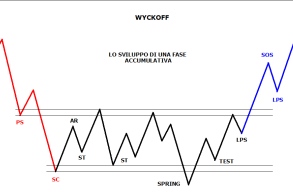
At this moment, the price slows down its downward movement, and then begins to move in the upward direction.
Events that occur during the accumulation phase
PS (preliminary support) shows the emergence of a significant number of buy trades after a long-term pullback, signaling that the downtrend may be coming to an end.
However, the volume of purchases is not yet enough to stop the price from falling further.
SC (Sales Climax - Selling Peak): This is the time when selling pressure reaches its peak.
Wyckoff's Composite Man Concept, Part Four
In the above articles , we have mentioned many times that words such as “big man” or “big power”, such people are also called - composite man in the market.
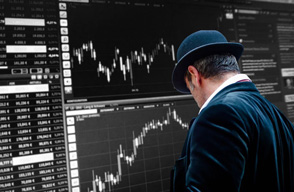
This aspect is also important in trading; the concept of a composite person is one of the fundamental concepts of the Wyckoff method.
In fact, constituent people ( market makers ) are individuals with great influence in the market, these include banks, investment companies, lending institutions and other financial institutions.
Essentially, these are investors with large capital, which allows them to significantly influence the volume of demand or supply.
5 steps to the market, the Wyckoff method, part five
The Wyckoff Method refers to a 5-step process of entering the market, selecting potential stocks, and opening trades.
Read the first part of the article on the method on the page - Basics of the Wyckoff method

Step 1: Identify a trend
The trend identification includes the determination of the current trend and forecasting the future direction of price by analyzing the structure of the market and the ratio of demand and supply.
Assessment of the future trend will help you decide whether to enter the market at the moment, and in which direction to make a deal?
Fibonacci tools in MT5
The beauty of financial markets is that not a single trader on the planet is limited in the way they can conduct technical analysis of the market and in the selection of tools that are needed for this.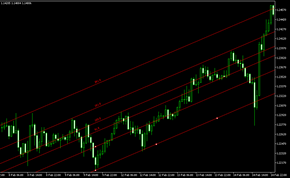
Many of the proposed options previously seemed completely fantastic, but later won the favor of traders.
The situation was the same with Fibonacci tools; for a long time, technical analysis using them aroused skepticism, but today the situation has changed radically.
Moreover, it has become possible to automatically construct graphical Fibo objects; this function is available in the MetaTrader 5 trading terminal.
Brief description of Fibonacci tools
The MT5 trading terminal is a godsend for traders who want to use Fibonacci tools in practice.
Signal indicators for Forex.
Not all beginners are able to independently find entry points into the market, even with the help of technical analysis indicators.
Therefore, if you are not strong in this matter, it would be more rational to use the so-called Signal Indicators.
Signal indicators give clear signals to open trades; the trader can only wait for the right moment and enter the market.
Typically, the work of such tools is not particularly different from other indicators; the output of results is simply optimized.
Indicators can draw arrows, sound a sound signal, or even notify you by email or SMS message.
Reversal indicators are the secret to successful trading.
One of the most important events in Forex is a trend reversal, when the price reverses its movement.
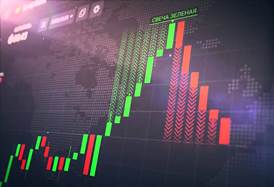
A trend reversal allows you to open a position at the moment a new trend emerges at the best price or close an existing deal at the most favorable rate.
The main thing is to determine in advance the beginning of the reversal; the easiest way to do this is with the help of so-called reversal indicators. They help make technical analysis in Forex much easier.
The best reversal indicators.
Chaos indicator – the signal for a reversal for this instrument is the intersection of multi-colored lines; it is this moment that indicates the beginning of a new trend.
Fibonacci Spiral - the magic of numbers in market forecasting
The Fibonacci spiral is the most mysterious tool in the hands of a Forex trader. Actually, if we talk about the Fibonacci sequence and various tools based on it, we can highlight a number of such popular tools as arcs, levels and the Fibonacci fan.
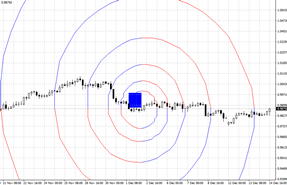
All of the above tools have a history of successful use in technical market analysis, as well as specific training instructions for use.
What is there to worry about, if all the above tools are present in all trading terminals known to us.
However, despite the popularity of all these tools, the
Fibonacci spiral is an exception, since almost no one uses it and not a single successful trader has written a practical tutorial on it.
What is a “reversal candle” and how to spot candlestick patterns?
Japanese candlesticks are one of the most popular types of chart displays. They allow traders to assess the situation on the market, conduct an analysis and understand how to proceed.
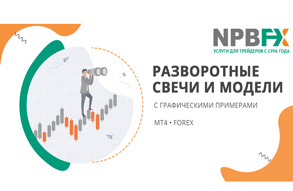
This is why without the ability to “read” candles it is very difficult to succeed in Forex.
Today, with the support of the dynamic broker NPBFX, we will figure out what a “reversal” candle is and how to detect reversal candlestick patterns on charts.
Reversal candles are those candles after which the market trend reverses in the opposite direction. In order to be sure that a candle is a reversal, you need to make sure that it necessarily follows an upward or downward trend.
Proven Forex trend indicators, selection of the best scripts
Much has already been said about the importance of determining the main trend of Forex price movement, there are many ways to solve this problem, but the most effective is still the use of special scripts.

It is the indicators that show the trend that most accurately determine the direction of the existing trend; in addition, the scripts determine a number of other characteristics that technical analysis uses.
Such as the strength of the trend and the likelihood of a reversal, these are the ones that will help when planning a transaction.
There are a huge number of such tools, and the metatrader trading platform has more than a dozen of them by default.
In addition, there are quite a few trend indicators created by third-party developers; we will try to get acquainted with the most effective of them.
The most effective indicators showing the trend
Pivot points

Many traders perceive these tips as the purely personal opinion of an expert who bases his calculations solely on his strategy.
However, almost all of these analysts use fairly simple formulas to calculate turning points, and most of their forecasts are of the same type.
Are you doing technical analysis on Forex and don't know how to calculate turning points?
After reading this article, you will no longer have problems finding these levels.
Calculation of turning points at five levels
Page 1 of 4
- To the begining
- Back
- 1
- 2
- 3
- 4
- Forward
- In the end

